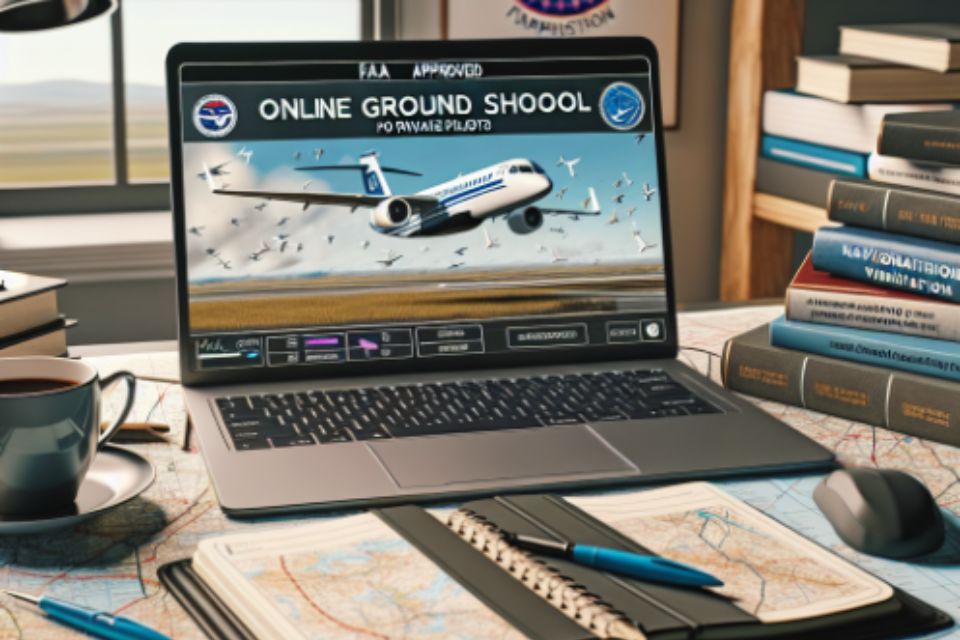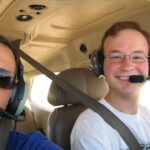Embarking on Your Aviation Journey: The Online Private Pilot Ground School
Imagine the freedom of soaring through the clouds, the world stretching out beneath you as you navigate the skies. That dream is closer than you think, and it starts right here with online private pilot ground school. With the convenience of digital learning, you can take the first crucial step towards earning your wings from the comfort of your own home.
Article-at-a-Glance
- Discover the essentials of becoming a private pilot through online ground school.
- Understand the FAA requirements for ground school training and certification.
- Learn how online courses are structured to maximize your learning experience.
- Gain insight into the core subjects covered in ground school curriculum.
- Get tips on how to effectively study online and prepare for your FAA exams.
Navigating the FAA Approval Terrain
The Federal Aviation Administration (FAA) sets the standards for flight training and certification. To become a private pilot, you must complete an FAA-approved ground school program. This ensures you have the theoretical knowledge necessary to fly safely and confidently. Online ground schools that meet these standards provide the same level of instruction as traditional classroom settings, with the added flexibility of self-paced study.
Unlocking the Digital Cockpit: A Guide to Online Ground School
Online ground school is your virtual cockpit, equipped with all the instruments and controls you need to navigate the theoretical aspects of flying. These programs offer interactive lessons, quizzes, and simulations that make complex concepts easier to grasp. You’ll cover everything from aerodynamics to navigation, all tailored to prepare you for the FAA written exam and your future in-flight training.
The Virtual Flight Plan: Structuring Your Online Training
Just like a well-planned flight, a structured approach to online ground school can set you up for success. These courses are designed to guide you through each topic in a logical sequence, building your knowledge as you progress. They often include a mix of video tutorials, reading materials, and practice tests to cater to different learning styles and reinforce your understanding.
Laying the Educational Foundation
Before you take to the skies, it’s crucial to have a solid grounding in the basics. Online ground school lays this foundation by teaching you the principles of flight, aircraft systems, and the regulations you’ll need to know as a pilot. This base of knowledge is not just for passing tests – it’s for your safety and the safety of your future passengers.
Flight Theory and Aviation Principles
Flight theory might seem daunting at first, but it’s the cornerstone of all pilot training. Online ground school breaks down these principles into manageable segments, explaining how and why an aircraft flies. You’ll delve into topics such as lift, thrust, drag, and weight, and see how they interplay to make aviation possible. This understanding is not only fascinating but also critical when you’re in the pilot’s seat.
Decoding the Weather: Meteorology for Pilots
Weather is a pilot’s friend and foe; understanding its language is critical. Online ground school demystifies meteorology, teaching you to interpret weather reports and forecasts, recognize hazardous conditions, and make informed decisions. You’ll learn about fronts, pressure systems, and how different weather phenomena can affect your flight plan. This knowledge is vital for safe and efficient flying, ensuring you’re prepared for whatever the skies may hold.
Preparing for Takeoff: The Online Ground School Curriculum
The curriculum of an online ground school is comprehensive, designed to cover all the knowledge areas the FAA requires for private pilots. It’s not just about passing the test; it’s about becoming a knowledgeable, competent pilot. From aerodynamics to navigation, from emergency procedures to aviation law, the courses are thorough and engaging, setting you up for success both on the ground and in the air.
Airspace Classification and Regulations
Navigating the airspace system is like understanding the rules of the road, but in the sky. Your online ground school will cover the different classes of airspace and what’s required to fly in each. You’ll learn about controlled, uncontrolled, and special use airspace, as well as the regulations that govern them. This knowledge ensures you fly legally, safely, and confidently, wherever your journey takes you.
Aircraft Operations and Performance
Every aircraft has its own personality, its own strengths and limitations. Online ground school courses will teach you the principles of aircraft operations and performance. You’ll understand how to calculate weight and balance, determine takeoff and landing distances, and manage fuel. These are the nuts and bolts of flying, the critical details that ensure a safe and enjoyable flight.
Communication and Air Traffic Control
Clear communication is the lifeblood of aviation safety. Through online ground school, you’ll learn the language of aviation, the proper use of radio communications, and how to interact effectively with air traffic control. These skills are crucial for maintaining situational awareness and ensuring coordinated, collision-free flying in the national airspace system.
Soloing Your Study Sessions: Effective Online Learning Strategies
Studying online requires discipline and strategy, much like flying solo for the first time. To make the most of your online ground school experience, you’ll need to develop effective study habits that keep you engaged and help you retain the vast amount of information you’ll be learning.
Creating a Study Routine
Consistency is key when it comes to studying. Set up a routine that fits into your life and stick to it. Whether it’s an hour every morning or a couple of evenings a week, having a regular schedule will help you progress steadily through the material. Remember, the goal is not just to pass the exam but to become a well-informed pilot who is ready for the responsibility of commanding an aircraft.
Maximizing Interactive Tools and Resources
Online ground school isn’t just about reading and watching videos. It’s interactive, with tools and resources designed to enhance your learning. Flight simulators, interactive maps, and flashcards bring the material to life, helping you understand complex concepts. Engage with these tools regularly to build your pilot’s intuition and get a feel for real-world flying scenarios without leaving the ground.
Test-Prep and Practice Exams
Practice makes perfect, especially when it comes to the FAA written exam. Online ground schools offer a wealth of practice questions and mock exams to prepare you for the real thing. These tests simulate the format and time constraints of the FAA exam, giving you a taste of what to expect. Use these resources to identify areas where you need more study, and watch your confidence grow with each practice session.
The Co-Pilot’s Checklist: Understanding FAA Certification
Getting your private pilot’s license is a journey that involves several steps. The FAA certification process is designed to ensure you have the knowledge and skills to fly safely. Understanding this process is like having a co-pilot in the cockpit – it guides you through what’s needed to achieve your goal. Let’s break down what you need to know to navigate this journey.
Earning Your Wings: The Path to Private Pilot Certification
- Complete a minimum of 35-40 hours of flight training (depending on the flight school’s certification).
- Pass a medical examination by an FAA-certified aviation medical examiner.
- Log at least 20 hours of flight training with an instructor and 10 hours of solo flight time.
- Pass the FAA written exam with a score of 70% or higher.
- Successfully complete a check-ride, which includes an oral exam and a flight test.
The Written Exam: What to Expect and How to Excel
The FAA written exam is a milestone in your pilot training. It’s a multiple-choice test that covers a range of topics from your ground school curriculum. To excel, focus on areas where you’re less confident, and take advantage of online practice tests. On exam day, manage your time wisely, read questions carefully, and remember, this is just one step in your aviation adventure.
Ground Control to Major Tom: Support and Resources
Even when studying online, you’re never flying solo. There’s a whole ground crew ready to support you. Online ground schools often provide access to instructors for questions, forums for peer support, and customer service for technical issues. These resources are your lifeline, ensuring you have the support you need to navigate your pilot training journey successfully.
FAQ: Your Questions Answered
Got questions? You’re not alone. Here are some of the most common queries aspiring pilots have about online ground school and the path to becoming a private pilot:
Getting In-Flight Support: Instructor Assistance
While the online ground school experience is self-directed, it doesn’t mean you’re on your own. Quality programs offer instructor support to answer your questions and clarify complex topics. This guidance is invaluable, as it simulates the in-flight support you’ll receive from a co-pilot or flight instructor. Don’t hesitate to reach out – these experts are here to help you navigate your studies and prepare for real-world flying.
Joining the Squadron: Community and Collaboration
Embarking on your pilot training is also about joining a community of like-minded individuals. Many online ground schools have forums or social media groups where students can connect, share experiences, and offer advice. Engaging with your peers can provide moral support, study tips, and may even lead to networking opportunities in the aviation industry. Remember, flying may be a solo activity, but learning to fly is a shared journey.
Clearing the Runway: Next Steps After Online Ground School
Once you’ve completed your online ground school, you’re ready to transition from theory to practice. The knowledge you’ve gained is the foundation for the hands-on skills you’ll develop in the cockpit. It’s time to find a flight school where you can earn your flight hours, practice maneuvers, and prepare for your check-ride under the guidance of a certified flight instructor.
Finding a Local Flight School for In-Air Training
Choosing the right flight school is a pivotal decision in your aviation journey. Look for schools that offer a good balance of quality instruction, well-maintained aircraft, and a culture of safety. Visit potential schools, talk to instructors, and observe training sessions. The goal is to find a place where you feel comfortable, supported, and excited to learn.
Beyond the Clouds: Building on Your Private Pilot License
Obtaining your private pilot license is just the beginning. With your license, you can continue to build hours, explore new destinations, and even pursue advanced ratings like instrument or commercial. Each step enhances your skills and opens up new possibilities in the world of aviation. The sky is not the limit; it’s your playground.
FAQ: Your Pre-Flight Briefing
Before you embark on your pilot training, you’re bound to have questions. Here’s a pre-flight briefing to address some common inquiries and set your mind at ease as you prepare for this exciting venture.
Can I Begin My Pilot Training Exclusively Online?
Yes, you can start your pilot training with an online ground school. This approach covers the theoretical knowledge you’ll need for the FAA written exam. However, to become a licensed pilot, you’ll also need to complete in-person flight training with a certified flight instructor to gain practical, hands-on experience.
What Are the Requirements for the FAA Private Pilot Written Exam?
The FAA private pilot written exam is a crucial step in your journey to becoming a pilot. To sit for this exam, you must be at least 16 years old and able to read, speak, and understand English. You’ll need to complete a ground school course, like the one you’ve been taking online, and receive an endorsement from your instructor confirming you’re prepared for the test. The exam itself consists of 60 multiple-choice questions, and you’ll need a score of 70% or higher to pass. It covers a range of topics, from flight principles and navigation to weather and FAA regulations.
How Does Online Ground School Compare to Traditional Classroom Training?
Online ground school offers a flexible alternative to traditional classroom training. While both formats cover the same essential curriculum required by the FAA, online programs allow you to learn at your own pace and on your own schedule. Interactive multimedia resources, such as videos, animations, and quizzes, can enhance the learning experience and cater to different learning styles. Classroom training, on the other hand, provides real-time interaction with an instructor and fellow students, which can be beneficial for immediate feedback and discussion.
Are Online Ground School Programs Self-Paced?
One of the major advantages of online ground school is that most programs are self-paced. This means you can progress through the course as quickly or slowly as you need, based on your individual learning style and schedule. This flexibility is ideal for those who have other commitments like work or school. However, it’s important to maintain discipline and a consistent study routine to ensure you complete the course and retain the information.
What Happens After I Complete an Online Ground School?
Completing an online ground school is a significant achievement, but it’s just one part of your pilot training. After finishing the course, you’ll take the FAA written exam. Once you’ve passed, you’ll move on to the next phase: flight training. This is where you’ll apply your theoretical knowledge in the air, under the supervision of a certified flight instructor. You’ll learn to handle an aircraft through various maneuvers, takeoffs, and landings, building up flight hours until you’re ready for the practical test, or check-ride, which is the final step to obtaining your private pilot license.
In conclusion, online ground school is a convenient, effective way to begin your private pilot training. It provides the flexibility to study on your own terms and the comprehensive education needed to pass the FAA written exam. Remember, the sky is vast and full of opportunities. With dedication, discipline, and the right resources, you can turn your dream of flying into a reality. So buckle up, set your course, and prepare for an incredible journey to becoming a private pilot.







Leave a Reply